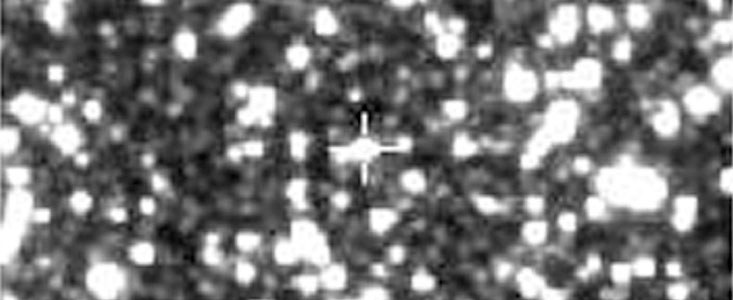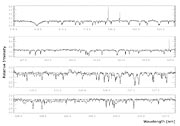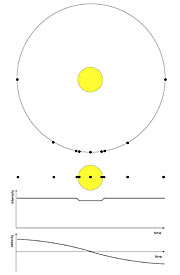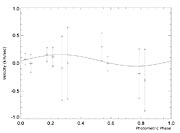Comunicato Stampa
Glowing Hot Transiting Exoplanet Discovered
VLT Spectra Indicate Shortest-Known-Period Planet Orbiting OGLE-TR-3
22 Aprile 2003
More than 100 exoplanets in orbit around stars other than the Sun have been found so far. But while their orbital periods and distances from their central stars are well known, their true masses cannot be determined with certainty, only lower limits. This fundamental limitation is inherent in the common observational method to discover exoplanets - the measurements of small and regular changes in the central star's velocity, caused by the planet's gravitational pull as it orbits the star. However, in two cases so far, it has been found that the exoplanet's orbit happens to be positioned in such a way that the planet moves in front of the stellar disk, as seen from the Earth. This "transit" event causes a small and temporary dip in the star's brightness, as the planet covers a small part of its surface, which can be observed. The additional knowledge of the spatial orientation of the planetary orbit then permits a direct determination of the planet's true mass. Now, a group of German astronomers [1] have found a third star in which a planet, somewhat larger than Jupiter, but only half as massive, moves in front of the central star every 28.5 hours . The crucial observation of this solar-type star, designated OGLE-TR-3 [2] was made with the high-dispersion UVES spectrograph on the Very Large Telescope (VLT) at the ESO Paranal Observatory (Chile). It is the exoplanet with the shortest period found so far and it is very close to the star, only 3.5 million km away. The hemisphere that faces the star must be extremely hot, about 2000 °C and the planet is obviously losing its atmosphere at high rate.
The search for exoplanets
More than 100 planets in orbit around stars other than the Sun have been found so far. These "exoplanets" come in many different sizes and they move in a great variety of orbits at different distances from their central star, some nearly round and others quite elongated. Some planets are five to ten times more massive than the largest one in the solar system, Jupiter - the lightest exoplanets known at this moment are about half as massive as Saturn, i.e. about 50 times more massive than the Earth.
Astronomers are hunting exoplanets not just to discover more such objects, but also to learn more about the apparent diversity of planetary systems. The current main research goal is to eventually discover an Earth-like exoplanet, but the available telescopes and instrumentation are still not "sensitive" enough for this daunting task.
However, also in this context, it is highly desirable to know not only the orbits of the observable exoplanets, but also their true masses . But this is not an easy task.
Masses of exoplanets
Virtually all exoplanets detected so far have been found by an indirect method - the measurement of stellar velocity variations . It is based on the gravitational pull of the orbiting planet that causes the central star to move a little back and forth; the heavier the planet, the greater is the associated change in the star's velocity.
This technique is rapidly improving: the new HARPS spectrograph (High Accuracy Radial Velocity Planet Searcher) , now being tested on the 3.6-m telescope at the ESO La Silla Observatory , can measure such stellar motions with an unrivalled accuracy of about 1 metre per second (m/s), cf. eso0308. It will shortly be able to search for exoplanets only a few times more massive than the Earth.
However, velocity measurements alone do not allow to determine the true mass of the orbiting planet. Because of the unknown inclination of the planetary orbit (to the line-of-sight), they only provide a lower limit to this mass . Additional information about this orbital inclination is therefore needed to derive the true mass of an exoplanet.
The transit method
Fortunately, this information becomes available if the exoplanet is known to move across ("transit") the star's disk, as seen from the Earth; the orbital plane must then necessarily be very near the line-of-sight. This phenomenon is exactly the same that happens in our own solar system, when the inner planets Mercury and Venus pass in front of the solar disk, as seen from the Earth [3]. A solar eclipse (caused by the Moon moving in front of the Sun) is a more extreme case of the same type of event.
During such an exoplanet transit, the observed brightness of the star will decrease slightly because the planet blocks a part of the stellar light. The larger the planet, the more of the light is blocked and the more the brightness of the star will decrease. A study of the way this brightness changes with time (astronomers refer to the "light curve"), when combined with radial velocity measurements, allows a complete determination of the planetary orbit, including the exact inclination. It also provides accurate information about the planet's size, true mass and hence, density.
The chances that a particular exoplanet passes in front of the disk of its central star as seen from the Earth are small. However, because of the crucial importance of such events in order to characterize exoplanets fully, astronomers have for some time been actively searching for stars that experience small regularly occurring "brightness dips" that might possibly be caused by exoplanetary transits.
The OGLE list
Last year, a first list of 59 such possible cases of stars with transiting planets was announced by the Optical Gravitational Lensing Experiment (OGLE) [2]. These stars were found - within a sample of about 5 million stars observed during a 32-day period - to exhibit small and regular brightness dips that might possibly be caused by transits of an exoplanet.
For one of these stars, OGLE-TR-56 , a team of American astronomers soon thereafter observed slight variations of the velocity , strongly indicating the presence of an exoplanet around that star.
UVES spectra of OGLE-TR-3
Now, a team of German and ESO astronomers [1] have used the UVES High-Dispersion Spectrograph on the 8.2-m VLT KUEYEN telescope at the Paranal Observatory (Chile) to obtain very detailed spectra of another star on that list, OGLE-TR-3 , cf. eso0311a, eso0311b.
Over a period of one month, a total of ten high-resolution spectra - each with an exposure time of about one hour - were obtained of the 16.5-mag object, i.e. its brightness is about 16,000 fainter that what can be perceived with the unaided eye. A careful evaluation shows that OGLE-TR-3 is very similar to the Sun, with a temperature of about 5800 °C (6100 K). And most interestingly, it undergoes velocity variations of the order of 120 m/s .
The exoplanet at OGLE-TR-3
The 2 per cent dip in the brightness of OGLE-TR-3, as observed during the OGLE programme, occurs every 28 hours 33 minutes (1.1899 days), cf. ESO Press Photo eso0311 . The UVES velocity measurements (ESO Press Photo eso0311) fit this period well and reveal, with high probability, the presence of an exoplanet orbiting OGLE-TR-3 with this period. In any case, the observations firmly exclude that the well observed brightness variations could be due to a small stellar companion. A red dwarf star would have caused velocity variations of 15 km/s and a brown dwarf star 2.5 km/s; both would have been easy to observe with UVES, and it is clear that such variations can be excluded.
Although the available observations are still insufficient to allow an accurate determination of the planetary properties, the astronomers provisionally deduce a true mass of the planet of the order of one half of that of Jupiter . The density is found to be about 250 kg/m 3, only one-quarter of that of water or one-fifth of that of Jupiter, so the planet is quite big for this mass - a bit "blown up". It is obviously a planet of the gaseous type .
A very hot planet
The orbital period, 28 hours 33 minutes (1.1899 days), is the shortest known for any exoplanet and the distance between the star and the planet is correspondingly small, only 3.5 million kilometres . The temperature of the side of the planet facing the star must therefore be very high, of the order of 2000 °C . Clearly, the planet must be losing its atmosphere by evaporation. The astronomers also conclude that it might in fact be possible to observe this exoplanet directly because of its comparatively strong infrared radiation. An attempt to do so will soon be made.
As only the third exoplanet found this way (after those at the stars HD209458 and OGLE-TR-56), the new object confirms the current impression that a considerable number of stars may possess giant planets in close orbits. Since such planets cannot form so close to their parent star, they must have migrated inwards to the current orbit from a much larger, initial distance. It is not known at this time with certainty how this might happen.
Future prospects
It is expected that more observational campaigns will be made to search for transiting planets around other stars. There is good hope that OGLE-TR-3 and OGLE-TR-56 are just the first two of a substantial number of exoplanets to be discovered this way.
Some years from now, searches will also begin from dedicated space observatories, e.g. ESA's Eddington and Darwin, and NASA's Kepler.
Note
[1] The team consists of of Stefan Dreizler, Sonja L. Schuh , Wilhelm Kley , Thomas Rauch and Klaus Werner (Institut für Astronomie und Astrophysik, Tübingen, Germany), Peter H. Hauschildt (HamburgerSternwarte, Germany), and Burkhard Wolff (ESO). Thomas Rauch is also associated with the Dr.-Remeis-Sternwarte (Bamberg, Germany).
[2] OGLE-TR-3 and 58 other stars on the OGLE-list were discovered during an extensive photometric search for planetary and low-luminosity object transits in the galactic disk stars within the third phase of the Optical Gravitational Lensing Experiment ( OGLE III , cf. the research paper by Udalski and collaborators in the Polish research journal "Acta Astronomica", Vol. 52, page 1).
[3] With the Mercury Transit on May 7, 2003 as a fine prelude to next year's Venus Transit on June 8, 2004 , ESO and the European Association for Astronomy Education (EAAE) , together with the Institut de Mécanique Céleste et de Calcul des Éphémérides (IMCCE) and the Observatoire de Paris in France, are launching a major public programme that allows all interested persons to participate actively. The common web-address is: www.eso.org/public/outreach/eduoff/vt-2004/.
Ulteriori Informazioni
The information contained in this press release is based on a research article which has just been published in the European research journal "Astronomy & Astrophysics" ("OGLE-TR-3: A Possible New Transiting Planet" by Stefan Dreizler and collaborators; Vol. 402, page 791; astro-ph/0303183).
Contatti
Stefan Dreizler
Institut für Astronomie und Astrophysik
Tübingen, Germany
Tel.: +49 7071 29 78612 L371
E-mail: dreizler@astro.uni-tuebingen.de
Sul Comunicato Stampa
| Comunicato Stampa N": | eso0311 |
| Legacy ID: | PR 09/03 |
| Nome: | OGLE-TR-3 |
| Tipo: | Milky Way : Star : Circumstellar Material : Planetary System |
| Facility: | Very Large Telescope |
| Instruments: | UVES |
| Science data: | 2003A&A...402..791D |
Our use of Cookies
We use cookies that are essential for accessing our websites and using our services. We also use cookies to analyse, measure and improve our websites’ performance, to enable content sharing via social media and to display media content hosted on third-party platforms.
ESO Cookies Policy
The European Organisation for Astronomical Research in the Southern Hemisphere (ESO) is the pre-eminent intergovernmental science and technology organisation in astronomy. It carries out an ambitious programme focused on the design, construction and operation of powerful ground-based observing facilities for astronomy.
This Cookies Policy is intended to provide clarity by outlining the cookies used on the ESO public websites, their functions, the options you have for controlling them, and the ways you can contact us for additional details.
What are cookies?
Cookies are small pieces of data stored on your device by websites you visit. They serve various purposes, such as remembering login credentials and preferences and enhance your browsing experience.
Categories of cookies we use
Essential cookies (always active): These cookies are strictly necessary for the proper functioning of our website. Without these cookies, the website cannot operate correctly, and certain services, such as logging in or accessing secure areas, may not be available; because they are essential for the website’s operation, they cannot be disabled.
Functional Cookies: These cookies enhance your browsing experience by enabling additional features and personalization, such as remembering your preferences and settings. While not strictly necessary for the website to function, they improve usability and convenience; these cookies are only placed if you provide your consent.
Analytics cookies: These cookies collect information about how visitors interact with our website, such as which pages are visited most often and how users navigate the site. This data helps us improve website performance, optimize content, and enhance the user experience; these cookies are only placed if you provide your consent. We use the following analytics cookies.
Matomo Cookies:
This website uses Matomo (formerly Piwik), an open source software which enables the statistical analysis of website visits. Matomo uses cookies (text files) which are saved on your computer and which allow us to analyze how you use our website. The website user information generated by the cookies will only be saved on the servers of our IT Department. We use this information to analyze www.eso.org visits and to prepare reports on website activities. These data will not be disclosed to third parties.
On behalf of ESO, Matomo will use this information for the purpose of evaluating your use of the website, compiling reports on website activity and providing other services relating to website activity and internet usage.
Matomo cookies settings:
Additional Third-party cookies on ESO websites: some of our pages display content from external providers, e.g. YouTube.
Such third-party services are outside of ESO control and may, at any time, change their terms of service, use of cookies, etc.
YouTube: Some videos on the ESO website are embedded from ESO’s official YouTube channel. We have enabled YouTube’s privacy-enhanced mode, meaning that no cookies are set unless the user actively clicks on the video to play it. Additionally, in this mode, YouTube does not store any personally identifiable cookie data for embedded video playbacks. For more details, please refer to YouTube’s embedding videos information page.
Cookies can also be classified based on the following elements.
Regarding the domain, there are:
- First-party cookies, set by the website you are currently visiting. They are stored by the same domain that you are browsing and are used to enhance your experience on that site;
- Third-party cookies, set by a domain other than the one you are currently visiting.
As for their duration, cookies can be:
- Browser-session cookies, which are deleted when the user closes the browser;
- Stored cookies, which stay on the user's device for a predetermined period of time.
How to manage cookies
Cookie settings: You can modify your cookie choices for the ESO webpages at any time by clicking on the link Cookie settings at the bottom of any page.
In your browser: If you wish to delete cookies or instruct your browser to delete or block cookies by default, please visit the help pages of your browser:
Please be aware that if you delete or decline cookies, certain functionalities of our website may be not be available and your browsing experience may be affected.
You can set most browsers to prevent any cookies being placed on your device, but you may then have to manually adjust some preferences every time you visit a site/page. And some services and functionalities may not work properly at all (e.g. profile logging-in, shop check out).
Updates to the ESO Cookies Policy
The ESO Cookies Policy may be subject to future updates, which will be made available on this page.
Additional information
For any queries related to cookies, please contact: pdprATesoDOTorg.
As ESO public webpages are managed by our Department of Communication, your questions will be dealt with the support of the said Department.





